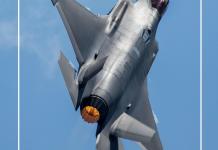American experts have warned that China could beat the US military using the technology the United States pioneered in the 1980s.
The US Navy researchers invented a new explosive with formidable capabilities in 1987, named China Lake Compound No. 20 (CL-20), after the Southern California base where it was developed.
MUST READ: US Air Force Testing MUTANT Missiles That Can ‘Twist & Tweak’ & Strike Highly Maneuverable Aerial Targets
The CL-20 had 40 percent greater penetrating power and propellant range than the US military’s mainstay explosives, first produced during World War II (WWII).
However, following the disintegration of the Soviet Union (USSR), the Pentagon’s sense of urgency to field new and advanced weaponry declined, which stunted the effort of perfecting CL-20 and designing weapons to use it.
China, however, understood the potential of the CL-20 and developed its version of this explosive material which began mass production in 2011.
Most of the long-range missiles fielded by China to prevent the US warships and non-stealthy aircraft, such as refueling tankers, from intervening if the Chinese military attacks Taiwan, are believed to be propelled by CL-20.
“This is a case where we could potentially be beaten over the head with our technology,” Bob Kavetsky, head of the Energetic Technology Center (ETC), a nonprofit research group that works for the US government, told Forbes.
For years now, Kavetsky and other experts in the field of energetics have been warning that the US, which was once a leader in explosives, has fallen dangerously behind China.
To worsen matters more, the US depends on China as a primary source for about a half dozen chemical ingredients in explosives, propellants, and other hostile foreign countries for another dozen.
If the US decides to intervene in a conflict in Taiwan Strait, the US military will face a greater number of Chinese missiles, including some with better range and power, made possible by Chinese advances in CL-20 and technology to make fuels burn more efficiently.
Also, the Chinese have invested heavily in developing and producing larger missiles than US forces can bring to the conflict by either air or sea.
“We can’t build enough ships and airplanes to carry the number of missiles necessary to reverse the firepower imbalance we have inside the first island chain,” said retired Major General Bill Hix, who served as the Army’s director of strategy after commanding forces in Afghanistan and Iraq, and has consulted for the Energetic Technology Center.
According to Hix, the only solution is new energetic materials enabling the US to produce smaller missiles with the same power so that more missiles could be carried by combat aircraft and warships and to develop longer-range weapons with more firepower.
China Overtakes The US
The cause of the decline in energetics development in the United States is the Pentagon’s focus on increasing the accuracy of weapons to realize greater lethality rather than explosive power, according to a 2021 Energetics Technology Center report commissioned by the Pentagon, after it was mandated to do so by the US Congress.
Between 1989 and 2011, US expenditure on munitions R&D decreased by 45 percent. Ever since, amid low-intensity conflicts in Iraq and Afghanistan against lightly armed enemies, the US has often been cutting the munitions budget to fund the development of large platforms like ships and aircraft.
On the other hand, China appears to be trying to position itself as a world leader in energetics. As per the data from Georgetown’s Center for Strategic and Emerging Technologies, over the last five years, Chinese researchers in energetics materials have published nearly seven times as many papers as their American counterparts.
Due to the dangers of handling explosives, and limited civilian applications of the materials involved, military explosives have been almost entirely developed and manufactured in US government facilities.
While some American military researchers have developed new explosives and propellants over the past few decades, none have been put into mass production.

In the US Defense Department, the work on energetics is distributed among different R&D units of the military, with no senior official appointed as a point person or someone to advocate for a change at a high level.
“No one who wakes up in the morning at DoD (US Defense Department) who only thinks about energetics,” Kavetsky said.
As for the production, almost all US explosives are produced at a single US Army plant in Holston, Tennessee, that goes back to WWII and is run by UK-based defense contractor BAE Systems.
Also, Kavetsky explains that the production processes are just as old, with explosives being prepared in 400-gallon vats resembling cake mixers.
It is impossible to produce CL-20 and many other advanced energetic materials using these processes, as they are synthesized in smaller amounts in chemical reactors.
Regarding the production scale, Kavetsky said it would be possible to produce 20,000 pounds of CL-20 annually with current amounts of precursor chemicals. However, large-scale use would need 2 million pounds a year, which he believes could take three to five years to step up.
“If DoD says we want large quantities,” he said, “industry will respond.”

US Is Concerned About Declining Stockpile Of Munitions
The war in Ukraine has sensitized Washington about the importance of munitions stockpiles after donating vast amounts of missiles, artillery shells, and other munitions to Ukraine and struggling to replenish them.
Also, there have been concerns over the increasing likelihood of China attacking Taiwan to reunite the island nation with the Chinese mainland forcefully.
Adding to these concerns is a report by a premier US think tank, the Center for Strategic and International Studies (CSIS), which predicted that the US would likely run out of some important precision-guided munitions within a week of the onset of a high-intensity conflict in the Taiwan Strait.
Last year, the US Defense Department (DoD) planned to spend 16 billion in the next 15 years to upgrade and expand its aging network of munition plants.
However, Kavetsky warns that the plan does not include developing the advanced manufacturing capabilities needed to mass produce new explosives like CL-20.
In its 2021 report, Energetics Technology Center (ETC) recommended the DoD establish a joint office to supervise the separate energetic efforts of the different services and authorize it to introduce new energetic materials into weapons systems.
The report also recommended the DoD privatize production and encourage the industry to develop new energetic materials by awarding $50 million a year in prototyping contracts for five years.
The report made various other recommendations, such as creating small pilot-scale production facilities, similar to pharmaceutical plants, that could switch between the production of several different precursor chemicals for explosives depending on demand.
The Pentagon is also considering other ways to bridge the firepower gap with China, such as researching ways to make current propellants burn more efficiently to increase the range of the missiles.
The Pentagon is also developing lasers and microwave weapons that can neutralize the incoming missiles out of the sky, which is considered an inexpensive alternative and also inexhaustible as long as they have a source of electricity.
Nevertheless, Hix still doubts that these alternatives would be ready within this decade and believes that the US would do well to increase its firepower with better explosives and propellants rapidly.
“A concerted effort on [explosives] is possible,” Hix said. “But we have to invest in it.”
- Contact the author at tanmaykadam700@gmail.com
- Follow EurAsian Times on Google News




